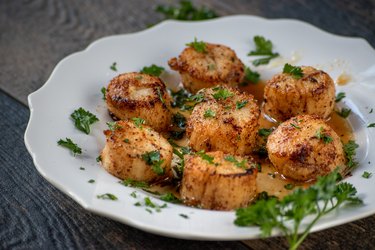
Sea scallops are sweet, meaty and easy to cook, and they are much larger than their less-expensive cousins, bay scallops. They add an elegant element to any meal whether they are sauteed, grilled or broiled. If you live in a region where fresh seafood is hard to come by, frozen scallops are almost equal in quality.
How to Thaw Scallops
Video of the Day
The best way to thaw scallops is to leave them in their original packaging and let them defrost in the refrigerator overnight. This can take as long as 24 hours depending on the number of scallops you're defrosting. To thaw large amounts, remove them from the packaging and spread them out on a sheet pan or shallow baking pan. Cover them tightly with plastic wrap and return them to the refrigerator.
Video of the Day
If you find yourself short on time, thaw the scallops in cool water in the sink. Leave them in their original packaging or transfer them to a zip-top bag you can close securely. Place the scallops in the sink or in a pot large enough to hold water to cover the scallops. Change the water every 10 minutes until the scallops thaw. This takes about half an hour.
The microwave method is quickest, but it's also the trickiest because the scallops may start to cook in the microwave. Transfer the scallops to a microwave-safe bowl and cover them with a layer of paper towels. Thaw for 30 seconds on the defrost setting or at 30 percent power. If your microwave doesn't have a defrost setting, or if you can't change the power level, don't use this method.
Tips for Buying and Preparing Scallops
Fresh scallops don't have a fishy odor, but you can't smell them if they're frozen. Look for sea scallops that are white, light orange or peach. Bay scallops are white, pinkish or light tan. Check that frozen scallops are uniform in size so they'll cook evenly.
Put the scallops between layers of paper towels before cooking and gently press them to release excess moisture. They'll brown better if you're frying or sauteing, and they won't make baked dishes soggy.
Always thaw scallops before cooking them. Frozen scallops will release liquid as they cook and become rubbery and tough before they're finished.
Tips for Cooking Scallops
It takes about three to five minutes to cook sea scallops. They're done when they're opaque, firm and milky white. Don't overcook them.
Scallops are mild in flavor, so don't be afraid to season them aggressively. They also benefit from being marinated or brushed with marinade while they're cooking. Avoid marinating them in citrus juice unless you're making ceviche because the juice will react with the scallops and create a texture resembling cooked seafood.
Cooked scallops keep two to three days in the refrigerator and three months in the freezer.
Methods for Cooking Scallops
- Saute: Heat a heavy-bottomed saute pan with equal parts of butter and olive oil. Season the scallops with pepper and place them flat-side down in the hot oil. When one side is browned, flip the scallops and cook the other side. Salt the scallops after they've cooked. Squeeze lemon juice over the scallops and serve. Experiment with other seasonings like paprika, lemon pepper or garlic.
- Bake: Grease a ceramic baking dish and season the scallops before placing them in a single layer in the dish. Heat the oven to 400 degrees Fahrenheit and bake for about 20 minutes or until the scallops are opaque and firm. You can also coat the scallops in seasoned bread crumbs before baking.
- Broil: Preheat the broiler. Place the scallops on a greased rack in a broiler pan. Season the scallops and brush them with a combination of melted butter and olive oil. Broil for three or four minutes, turn the scallops and brush them with butter and olive oil before returning them to the broiler. Cook for another three or four minutes or until the scallops are opaque and firm.
- Grill: Heat the grill to medium temperature and brush the grill grate with oil. Thread the scallops onto skewers, season them and place them over direct heat for five to eight minutes, turning once.